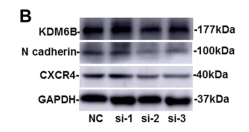JMJD3 Antibody - #DF13101
| Product: | JMJD3 Antibody |
| Catalog: | DF13101 |
| Description: | Rabbit polyclonal antibody to JMJD3 |
| Application: | WB |
| Cited expt.: | WB |
| Reactivity: | Human, Mouse |
| Prediction: | Bovine, Horse, Sheep, Rabbit, Dog |
| Mol.Wt.: | 177 kDa; 177kD(Calculated). |
| Uniprot: | O15054 |
| RRID: | AB_2846061 |
Related Downloads
Protocols
Product Info
*The optimal dilutions should be determined by the end user. For optimal experimental results, antibody reuse is not recommended.
*Tips:
WB: For western blot detection of denatured protein samples. IHC: For immunohistochemical detection of paraffin sections (IHC-p) or frozen sections (IHC-f) of tissue samples. IF/ICC: For immunofluorescence detection of cell samples. ELISA(peptide): For ELISA detection of antigenic peptide.
Cite Format: Affinity Biosciences Cat# DF13101, RRID:AB_2846061.
Fold/Unfold
Histone demethylase JMJD3; JmjC domain containing protein 3; JmjC domain-containing protein 3; Jumonji D3; Jumonji domain containing 3; Jumonji domain containing 3 histone lysine demethylase; Jumonji domain containing protein 3; Jumonji domain-containing protein 3; Kdm6b; KDM6B_HUMAN; KIAA0346; Lysine demethylase 6B; Lysine K specific demethylase 6B; Lysine specific demethylase 6B; Lysine-specific demethylase 6B;
Immunogens
A synthesized peptide derived from human JMJD3, corresponding to a region within the internal amino acids.
- O15054 KDM6B_HUMAN:
- Protein BLAST With
- NCBI/
- ExPASy/
- Uniprot
MHRAVDPPGARAAREAFALGGLSCAGAWSSCPPHPPPRSAWLPGGRCSASIGQPPLPAPLPPSHGSSSGHPSKPYYAPGAPTPRPLHGKLESLHGCVQALLREPAQPGLWEQLGQLYESEHDSEEATRCYHSALRYGGSFAELGPRIGRLQQAQLWNFHTGSCQHRAKVLPPLEQVWNLLHLEHKRNYGAKRGGPPVKRAAEPPVVQPVPPAALSGPSGEEGLSPGGKRRRGCNSEQTGLPPGLPLPPPPLPPPPPPPPPPPPPLPGLATSPPFQLTKPGLWSTLHGDAWGPERKGSAPPERQEQRHSLPHPYPYPAPAYTAHPPGHRLVPAAPPGPGPRPPGAESHGCLPATRPPGSDLRESRVQRSRMDSSVSPAATTACVPYAPSRPPGLPGTTTSSSSSSSSNTGLRGVEPNPGIPGADHYQTPALEVSHHGRLGPSAHSSRKPFLGAPAATPHLSLPPGPSSPPPPPCPRLLRPPPPPAWLKGPACRAAREDGEILEELFFGTEGPPRPAPPPLPHREGFLGPPASRFSVGTQDSHTPPTPPTPTTSSSNSNSGSHSSSPAGPVSFPPPPYLARSIDPLPRPPSPAQNPQDPPLVPLTLALPPAPPSSCHQNTSGSFRRPESPRPRVSFPKTPEVGPGPPPGPLSKAPQPVPPGVGELPARGPRLFDFPPTPLEDQFEEPAEFKILPDGLANIMKMLDESIRKEEEQQQHEAGVAPQPPLKEPFASLQSPFPTDTAPTTTAPAVAVTTTTTTTTTTTATQEEEKKPPPALPPPPPLAKFPPPSQPQPPPPPPPSPASLLKSLASVLEGQKYCYRGTGAAVSTRPGPLPTTQYSPGPPSGATALPPTSAAPSAQGSPQPSASSSSQFSTSGGPWARERRAGEEPVPGPMTPTQPPPPLSLPPARSESEVLEEISRACETLVERVGRSATDPADPVDTAEPADSGTERLLPPAQAKEEAGGVAAVSGSCKRRQKEHQKEHRRHRRACKDSVGRRPREGRAKAKAKVPKEKSRRVLGNLDLQSEEIQGREKSRPDLGGASKAKPPTAPAPPSAPAPSAQPTPPSASVPGKKAREEAPGPPGVSRADMLKLRSLSEGPPKELKIRLIKVESGDKETFIASEVEERRLRMADLTISHCAADVVRASRNAKVKGKFRESYLSPAQSVKPKINTEEKLPREKLNPPTPSIYLESKRDAFSPVLLQFCTDPRNPITVIRGLAGSLRLNLGLFSTKTLVEASGEHTVEVRTQVQQPSDENWDLTGTRQIWPCESSRSHTTIAKYAQYQASSFQESLQEEKESEDEESEEPDSTTGTPPSSAPDPKNHHIIKFGTNIDLSDAKRWKPQLQELLKLPAFMRVTSTGNMLSHVGHTILGMNTVQLYMKVPGSRTPGHQENNNFCSVNINIGPGDCEWFAVHEHYWETISAFCDRHGVDYLTGSWWPILDDLYASNIPVYRFVQRPGDLVWINAGTVHWVQATGWCNNIAWNVGPLTAYQYQLALERYEWNEVKNVKSIVPMIHVSWNVARTVKISDPDLFKMIKFCLLQSMKHCQVQRESLVRAGKKIAYQGRVKDEPAYYCNECDVEVFNILFVTSENGSRNTYLVHCEGCARRRSAGLQGVVVLEQYRTEELAQAYDAFTLAPASTSR
Predictions
Score>80(red) has high confidence and is suggested to be used for WB detection. *The prediction model is mainly based on the alignment of immunogen sequences, the results are for reference only, not as the basis of quality assurance.
High(score>80) Medium(80>score>50) Low(score<50) No confidence
Research Backgrounds
Histone demethylase that specifically demethylates 'Lys-27' of histone H3, thereby playing a central role in histone code. Demethylates trimethylated and dimethylated H3 'Lys-27'. Plays a central role in regulation of posterior development, by regulating HOX gene expression. Involved in inflammatory response by participating in macrophage differentiation in case of inflammation by regulating gene expression and macrophage differentiation. Plays a demethylase-independent role in chromatin remodeling to regulate T-box family member-dependent gene expression by acting as a link between T-box factors and the SMARCA4-containing SWI/SNF remodeling complex (By similarity).
Nucleus.
Belongs to the UTX family.
References
Application: WB Species: Human Sample: BMSCs
Restrictive clause
Affinity Biosciences tests all products strictly. Citations are provided as a resource for additional applications that have not been validated by Affinity Biosciences. Please choose the appropriate format for each application and consult Materials and Methods sections for additional details about the use of any product in these publications.
For Research Use Only.
Not for use in diagnostic or therapeutic procedures. Not for resale. Not for distribution without written consent. Affinity Biosciences will not be held responsible for patent infringement or other violations that may occur with the use of our products. Affinity Biosciences, Affinity Biosciences Logo and all other trademarks are the property of Affinity Biosciences LTD.

